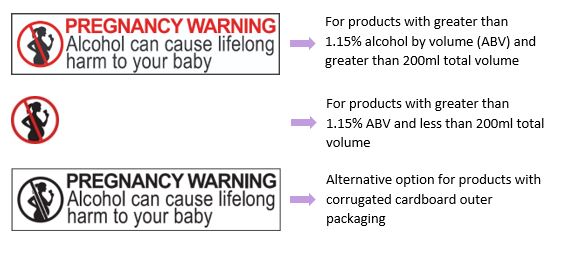Alcohol retailers exploiting pregnancy warning loophole, putting babies at risk

New research by The George Institute for Global Health published today in Drug and Alcohol Review has revealed Australia’s largest alcohol retailers are failing to display mandatory pregnancy warnings on their websites, potentially putting customers’ unborn children at risk of lifelong harms including permanent brain damage.1,2
Data for 8,343 alcoholic beverages sold on the websites of the two largest alcohol retailers in Australia were collated from 1-3 August 2023 to see whether the pregnancy warning was visible for consumers when purchasing alcohol online. The data collection intentionally coincided with the conclusion of the three-year implementation period for the warning label.
The George Institute team found virtually no products (0.1%) had the mandatory pregnancy warning visible on the item’s landing page, and for just 7% of products consumers could see the warning but only if they opted to view from another angle.1 In addition, warnings were twice as likely to be visible on the web pages for beer and cider products compared to wine, spirits, or premix products.1
Substantial evidence shows drinking alcohol during pregnancy can cause low birthweight, premature birth, and foetal alcohol spectrum disorder (FASD) in unborn babies, leading to health issues throughout life, including physical, cognitive, developmental, and behavioural abnormalities.2
Professor Simone Pettigrew, lead author, Head of Health Promotion at The George Institute for Global Health and Professor at the Faculty of Medicine, UNSW Sydney, said women have a right to know if something they are drinking may harm their babies.
“Our latest research shows that Australia’s online alcohol retailers are failing to protect their customers’ unborn children by not making important health information clearly visible on the main product pages,” she said.
“Alcohol companies should know full well that drinking alcohol in pregnancy can cause irreparable harm to children. They are obviously exploiting the fact that labelling laws are yet to explicitly include making the warning visible in product photography in the online setting.
“These websites are a critical sales channel, but customers cannot pick up and view the item like they can in a store,” she added. “Australia’s regulators must move to close this loophole because this may be a deliberate strategy to avoid alerting women to the warnings.”
In 2020, Australia’s alcohol industry was given three years to display pregnancy warning labels on all products. The new policy came about after more than 20 years of lobbying by public health advocates and is in line with World Health Organization recommendations.
“The almost complete absence of the mandatory pregnancy warning on the main product pages of major alcohol retailers’ websites shows we have a serious problem with regulatory gaps as consumers increasingly shift to online shopping,” said Adjunct Professor Terry Slevin, Chief Executive Officer of the Public Health Association of Australia.
“Alcohol companies fought tooth and nail against the introduction of alcohol pregnancy warning labels, and they continue to behave irresponsibly on this issue, which is so important to the health of unborn children,” he continued. “This research by The George Institute reflects the fact that there is no regulation requiring them to display the pregnancy warning online, resulting in retailers failing to take this important step. New regulation is needed to ensure that mandatory information requirements for harmful products are being applied online.”
Professor Pettigrew said pregnant women must be supported to make safer choices by giving them warning information, which has been shown to motivate them to avoid drinking while pregnant.3,4
Australia’s mandatory pregnancy warning labels:

References:
- Pettigrew S. et al. The absence of mandatory pregnancy warning labels in online alcohol purchasing contexts, Drug and Alcohol Review, 20 March 2024. DOI: 10.1111/dar.13836
- AIHW Australia’s mothers and babies. https://www.aihw.gov.au/reports/mothers-babies/australias-mothers-babies/contents/antenatal-period/alcoholAccessed 5 March 2024
- Pettigrew, S., Booth, L., McCausland, T., Kennington, K., Miller, M., Bowden, J., & Stafford, J. (2023). Evaluation outcomes of an alcohol and pregnancy campaign targeting multiple audiences. Drug and Alcohol Review, 42(1), 36-45
- Pettigrew, S., Booth, L., McCausland, T., Kennington, K., & Keric, D. (2023). Evaluation outcomes of a Western Australian campaign designed to reduce alcohol use in pregnancy. Australian and New Zealand Journal of Public Health, 47(6), 100102
Stay connected and updated
Subscribe to our mailing list for the latest news, events, and updates in health research.

